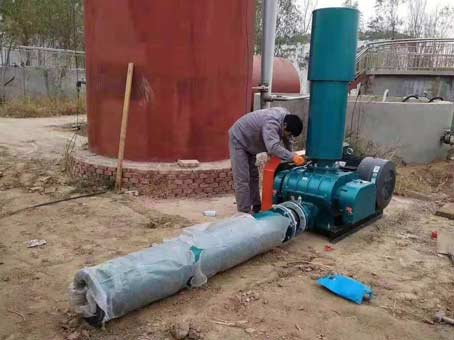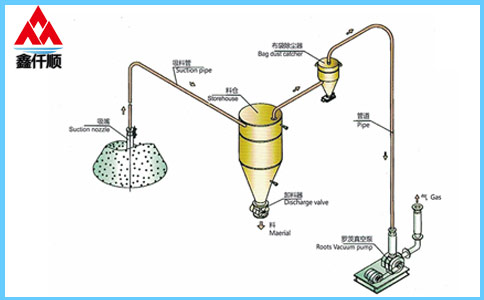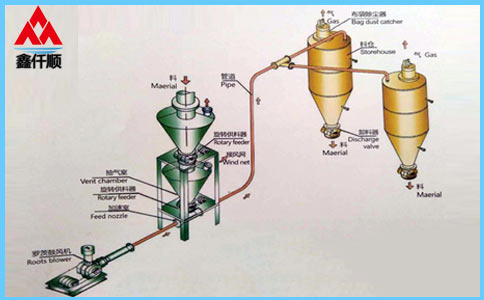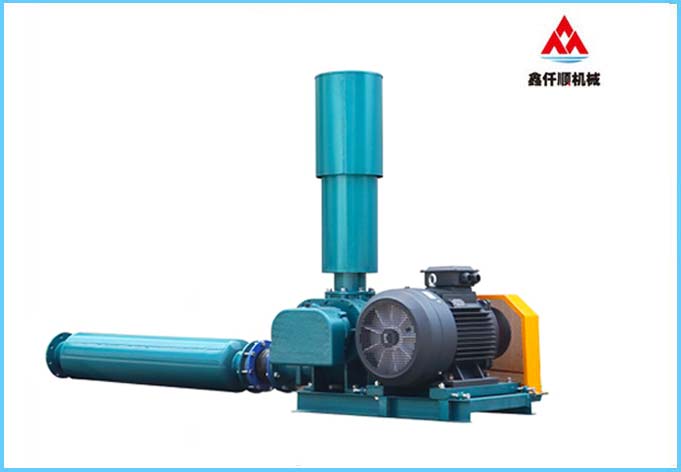It is normal that roots blower produces some normal noise during operation. As long as there is no abnormal change in the sound, there is no need to worry. If the working environment needs to be quiet, some noise elimination equipment can be used. Roots blower is a typical displacement blower, which converts the mechanical energy added by the prime mover into the pressure and kinetic energy of gas by changing the rotor volume. Compared with the centrifugal blower, Roots blower has the advantages of high pressure head, small flow resistance, stable air supply, etc., but it generally has the disadvantages of low efficiency and high noise in the process of use. The maintenance and installation of the fan play an important role in reducing noise, and can not be ignored. You should take good care of Roots blower.
The noise of Roots blower mainly includes: aerodynamic noise radiated from inlet and outlet; Mechanical noise radiated by casing wall and motor; Solid sound and electromagnetic noise radiated by foundation vibration. The noise characteristics of Roots blower are generally related to the flow, speed, static pressure and other factors of the fan. Roots blowers are widely used in the pneumatic conveying systems of ceramics, building materials, paper making, electricity, petroleum, chemical, textile, aquaculture, sewage treatment, food and other industries to transport air and various neutral gases. However, it is not suitable for conveying flammable, explosive, toxic and highly corrosive gases. The product has high processing precision, good performance, reliable operation, long service life, simple structure, and convenient maintenance. Including accessories, the main body of the fan is standardized and has a perfect mass production system, which can meet your requirements at any time. When the fan operates within the pressure rise range of 80kPa, no cooling water is required.
1. Noise due to impeller rotation
When the impeller rotates, friction or impact will occur with air. The faster the speed is, the higher the frequency of the connecting air is, and the sharper the noise is. The faster the speed is, the higher the frequency of the connecting air is, and the sharper the noise is. This phenomenon is more obvious when the width or thickness of the impeller increases. This phenomenon is more obvious when the width or thickness of the impeller increases. The frequency of noise is compounded by a variety of frequencies, which are related to the speed of the fan. The frequency of noise is compounded by a variety of frequencies, which are related to the speed of the fan.
If the axial flow fan is equipped with moving wing and static wing, the number of impellers should be different to avoid greater noise resonance. If the axial flow fan is equipped with moving wing and static wing, the number of impellers should be different to avoid greater noise resonance. However, whether it is axial flow or centrifugal fan, the noise generated by fast wind speed and high wind pressure is also large. However, whether it is axial flow or centrifugal fan, the noise generated by fast wind speed and high wind pressure is also large.
2. Noise will also be generated due to vortex generated by impeller
During the operation of the fan, vortex will be generated on the back of its moving wing, which will not only reduce the efficiency of the fan, but also generate noise. During the operation of the fan, vortex will be generated on the back of its moving wing, which will not only reduce the efficiency of the fan, but also generate noise. In order to reduce this phenomenon, the installation angle of the impeller shall not be too large, and the impeller shall be bent smoothly, and the sudden change shall not be too large. In order to reduce this phenomenon, the installation angle of the impeller shall not be too large, and the impeller shall be bent smoothly, and the sudden change shall not be too large.
3. Noise due to turbulence
When the air is flowing, if it encounters sharp obstacles, turbulence will easily occur. Although this turbulence is different from eddy current, it will also produce noise or high frequency whistling sound, which will also cause efficiency loss for the fan. Although this turbulence is different from eddy current, it will also produce noise or high frequency whistling sound, which will also cause efficiency loss for the fan.
4. Resonance with air duct shell causes noise
The joint between the air duct and the inner surface of the fan housing shall be flat to avoid the sound of tearing caused by roughness. The joint between the air duct and the inner surface of the fan housing shall be flat to avoid the sound of tearing caused by roughness. However, the connected pipeline will produce resonance, which will make the subtle sound bigger and cause greater noise. However, the connected pipeline will produce resonance, which will make the subtle sound bigger and cause greater noise. During design, sometimes the air duct can be covered with sound proof materials to reduce noise. During design, sometimes the air duct can be covered with sound proof materials to reduce noise.
5. Noise caused outside the fan
In addition to the fixed noise of the fan itself, there are many noise sources. Abnormal noise may be caused by insufficient precision, improper assembly or poor maintenance of bearings. In addition to the fixed noise of the fan itself, there are many noise sources, such as abnormal noise caused by insufficient precision, improper assembly or poor maintenance of bearings.
Text term label: Roots blower
Link to this article: //wuhanzhcs.com/html/news/n02/728.html










